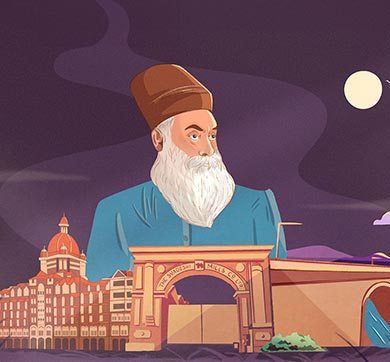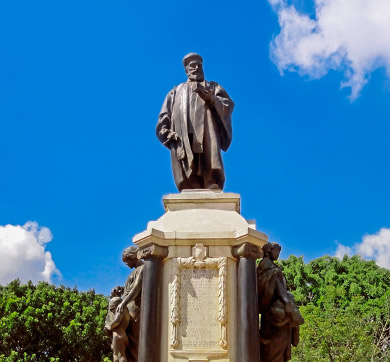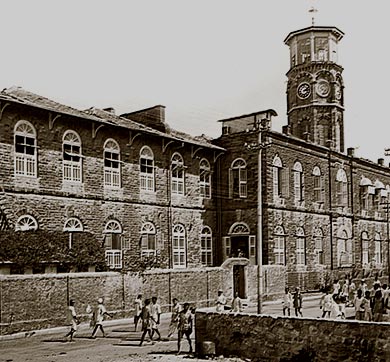March 2024 | 1374 words | 5-minute read
From altruistic to visionary, there are many titles that have been used to describe our Founder Jamsetji Nusserwanji Tata. His influence can be felt across many enterprises and sectors. Some of these are well known, carrying the Tata name with pride. Others lie outside the company, like gems scattered across the country he loved.
As we celebrate his birth anniversary, we look at some of the titles that can be used to describe the legend and the vast heritage he bequeathed.
Trailblazer
Legacies might last forever, but they all start somewhere and one of Jamsetji Tata’s earliest began with cotton. A growing industry in the late 1800s, many cotton mills were being established across India, with Bombay at its centre. Our Founder acquired a dilapidated and bankrupt oil mill in 1869. Demonstrating what would be considered a legendary business acumen by generations to come, he turned the newly renamed Alexandra Mill into a profit-making textile factory in just two years.
Gaining experience from Alexandra Mill and travels to the Middle East, where he came across fine Egyptian cotton, and England, where he came across modern cotton manufacturing, he knew that he wanted his next venture into textiles to incorporate the best of both. In 1874, he looked outside Mumbai — then called India’s Manchester in a nod to the British cotton hub — to find a place to build a cotton mill that was centrally located to both the source and transport routes. He began this venture in Nagpur, a location that many of his contemporaries considered to be a waste of time and money. The Empress Mills went on to show Our Founder’s penchant to see hitherto unconsidered possibilities. They also symbolised the beginnings of many of the Core Values that the Group holds close to this day.
Perhaps one of the best examples of this would be the way in which Empress Mills became a testing ground for innovative modern machinery. Jamsetji embraced the experimental ring spindle, an innovation not yet fully accepted in America, where it was developed. Despite this, he didn’t hesitate to run the machinery at full capacity at his mills, fixing any problems as came up. This led to production being doubled and the Empress Mills leading the way for the modern cotton industry.
Futurist
The truth behind Jamsetji’s success lies in how he saw the future. His interest in building the economic and technological foundations of India came from the vision he had of an industrialised nation that was on par with the Western world.
From tracking mineral deposit findings in India for potential steel production to thinking of using the waterfalls of the Narmada River, in Jabalpur, to power industry as early as 1875, he kept his eyes trained on present actions in India and beyond for all that could allow the country to achieve its full potential. The vision he had for the industrialised future of India was one that he had meticulously planned for — a plan that his successors carried through.
Nothing encapsulated this as much as the establishment and rise of Jamshedpur. A city that did not have a chance to leave the drawing board while Our Founder was alive, but where his presence can be felt in every aspect of its creation. Jamshedpur, and the Tata Steel plant at its centre, were visions he had invested time, energy and effort into realising, and his successors ensured that both did more than live up to the standards he had set.
Jamsetji’s faith in the future comes through not only in the plans he had for the town but in his confidence that Tata Steel would play a pivotal role in India’s industrialisation as India’s 1st integrated steel plant. So much so that despite scepticism from those in positions of authority, Our Founder had taken to carrying samples of coal and iron ore that he found during his prospecting for testing as far as Germany, England and America to gather more knowledge.
Jetsetter
A lover of travel and adventure, Our Founder planned trips often with the goal of learning about new advancements made in various fields. Oftentimes, when he travelled, he would bring back new and interesting technology that he found — from an electric piano to the cinematograph. He routinely planned his travels to “coincide with some Great Exhibitions” according to biographer Frank Harris who wrote Jamsetji Nusserwanji Tata, A Chronicle of His Life, and visited the Great Exhibition held in Paris, Germany and Chicago. Travelling the world allowed him to meet a variety of thinkers, encounter problems and possible hurdles that other countries were facing well before they landed on Indian shores and find ways to mitigate them.
The breadth of his vision and forethought is standing today along the shoreline of Mumbai as one of India’s most magnificent hotels, the Taj Mahal Palace, Mumbai. He built what was then the best hotel “East of the Suez”, with the most up-to date comforts and luxuries. From Turkish baths to contracting a German company to make sure there was electricity running, the hotel was at the front of both luxury and innovation. The Taj Mahal Palace, Mumbai stands to date as one of the greatest luxury hotels filled the richest of history, the most modern of amenities and the best of art from around the world.
Hobbyist
Jamsetji was a lover of art and books, collecting both on his trips around the world and building a collection that he often perused. His home in Mumbai boasted an extensive grand library and tasteful art collection.
Our Founder truly enjoyed experimentation and advancements in all fields, which led to him being amongst the first Indians to own a motorcar in 1901. He even ensured that his employees were trained in handling this new technology as he strongly believed that Indians should be able to do things for themselves. Meanwhile, his Bengaluru property was site to many horticultural experiments as he often sent cuttings of plants he had not seen before. His goal, when asked was “seeking for trees, that can be cultivated... If one tree thrives and helps to feed the people, my purpose is served”. This led to a few failed experiments, but failure neither dimmed his interest nor any further attempts.
It could be said that some his biggest interests, however, were ones that involved other people. He believed in the importance of community and recreational spaces and was an active member of several clubs, some of which he even helped establish. He also was a founding member of Mumbai’s Parsi Gymkhana along with his older son, Sir Dorabji Tata, and supported various other efforts in sports.
Humanitarian
Perhaps, Jamsetji’s biggest contribution to his country, aside from the bustling modern industry would be his humanitarian efforts. While pursuing success at the Empress Mills, he had turned his interests towards the betterment of people, a value that always remained his priority. Despite sustaining a loss in the beginning, he provided everything to ensure that all his employees had good living conditions, far ahead of what was mandated or even expected at the time. This included free access to medical care, subsidised access to necessities and various activities for the general wellbeing of all. He ensured that all his employees’ children had access to education, regardless of their gender, and provided supervised creches for the younger children.
The JN Tata Endowment for the Higher Education of Indians was another step taken in the direction of ensuring education opportunities for all regardless of gender. The first benefactors were Dr Freany K Cama and Dr Krishnabai Kelavkar who, after studying in the UK, went on to contribute extensively to the area of diseases for women and children in India. The Trust was not the limit of the vision Jamsetji saw, as he had plans for a post-graduate science university, a vision his son Sir Dorabji brought to life as the Indian Institute of Science.
Our Founder’s vision for the future looked well beyond the economic prosperity of India. He believed in his country “and [had] a great pride in its progress”. To try to contain his story to one sector does not fully acknowledge the depth and scope of the man and his legend that continues to live on.
- Archana Warrier



